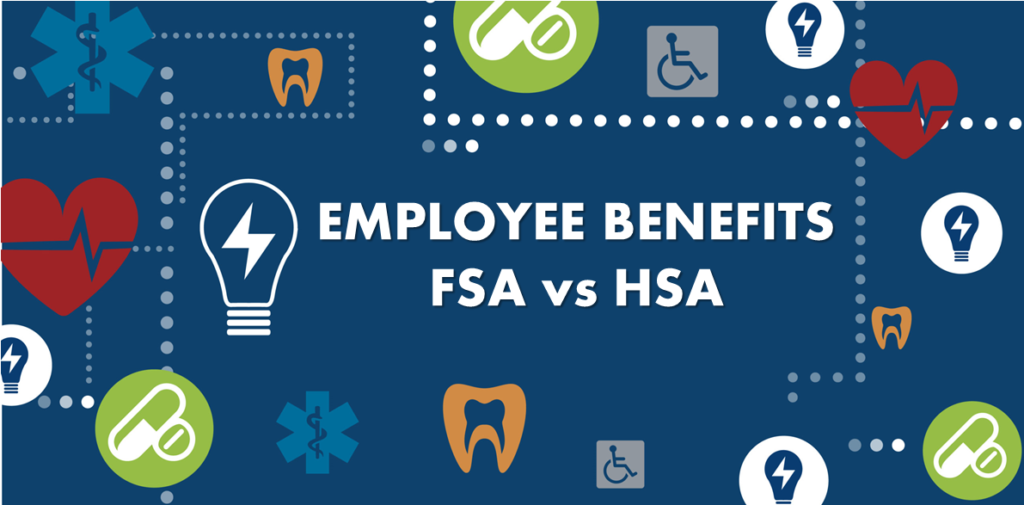As a recent graduate entering the workforce, I know firsthand that the transition can be daunting. There are many new things to learn and decisions to make, not just related to your job responsibilities, but also associated with the benefits offered by your employer. In addition to the obvious benefits like paid time off or health insurance, other options offered as part of the compensation package can provide tax-savings opportunities that should be considered.
Many employees can elect to participate in an employer-offered medical savings account, such as, an FSA or an HSA. It is important to understand how both accounts work, along with the advantages and disadvantages that come with each, before deciding which one is right for you. This article will review and compare each type of account and provide examples to help you make the best choice for your personal income tax situation.
What Is an FSA?
A Flexible Spending Account (FSA) is a tax-advantaged savings account that can be used to pay qualified out-of-pocket medical expenses. An FSA is self-funded (can also be funded by an employer) with pre-tax dollars. The account is established through your employer and works in tandem with a PPO or HMO employer-sponsored health insurance plan. The funds in the FSA can be used to pay for qualified medical expenses for you, your spouse, or eligible dependents.
An advantage of an FSA is the immediate availability of funds. Upon enrollment and commitment to contribute a certain amount of pre-tax dollars, these dollars can be used for qualified medical expenses immediately and in full. The employer funds the entire amount up front, and the employee has periodic amounts withheld from his/her paycheck to allow the elected amount to be fully funded by year-end. The IRS allows contributions up to $3,050 for 2023.
The disadvantages of an FSA are important to understand before establishing an account. First, is the fact that the account is unable to be transferred to a new employer or to the employee upon leaving the current employer. This risk should be considered if there is any possibility of terminating employment before the funds are depleted. Another potential negative aspect of an FSA is the “use it or lose it” requirement. If the amount contributed to the FSA is not fully utilized for qualified medical expenses within the year, it will be forfeited. As such, it is important to calculate your expected out-of-pocket medical costs carefully so that you do not leave any unspent funds in the account.
There are two exceptions to the “use it or lose it” rule that an employer can elect to offer for employees: an extended grace period to use the FSA for qualified medical expenses after year-end, and a rollover period that extends into the following year. With the extended grace period, FSA funds are available to be spent for an additional 2½ months after year end, or, in other words, by March 15th of the following year. For 2023, the IRS limitation on funds rolled over into 2024 is $610.
What Is an HSA?
Like an FSA, a Health Savings Account (HSA) is a tax-advantaged way to save pre-tax dollars that can be used for qualified medical expenses. This employee-account can be used to pay for qualified medical expenses for yourself or qualifying family members (depending on whether the account is an individual or family account). For 2023, contribution limits are $3,850 for an individual account or $7,750 for a family account.
Some advantages of an HSA over an FSA are that it can be moved from employer to employer and that there are no restrictions as to when the funds must be used. All contributions made to an HSA that are not used by the end of the year can be rolled over into the next year.
Additionally, HSA funds may be invested in stocks and bonds, which allows the account to grow further, tax-free. Distributions will not be taxable if they are used for qualified medical expenses. However, distributions that are withdrawn, but not used for medical expenses, are subject to ordinary income tax and an additional 20% tax if you are not yet 65 years old.
It should be noted that self-employed individuals are able to fund an HSA and take a tax deduction for the contributions on their individual tax returns.
A disadvantage to the HSA account is that there are several requirements that you must meet to enroll. These requirements include: you must participate in a high-deductible health plan (HDHP) as defined by the IRS; you cannot be claimed as a dependent on anyone else’s personal income tax return; and, you cannot also be enrolled in Medicare.
Comparing the Two Types of Plans
Flexible Spending Account (FSA) |
Health Savings Account (HSA) |
|
Established with employer; cannot be transferred between employers |
Employer-sponsored or self-sponsored; can be transferred between employers |
|
Contribute up to $3,050 in 2023 |
Contribute up to $3,850 self-coverage; $7,750 for family coverage in 2023 |
|
Immediate funds |
Investing opportunities (20% additional tax if not used for medical expenses) |
|
Use it or lose it (exceptions may apply) |
Can be rolled over into the next year |
|
No requirements for enrollment |
Must meet requirements in order to enroll |
Example of Tax Benefits of FSA/HSA Contributions
Facts:
- An individual employee with gross wages of $60,000
- Effective Federal tax rate assumed at 10%; State tax rate assumed at 3.07%
- FICA/Medicare employee tax rate = 7.65%
- Example excludes any city tax ramifications
Net annual cash to employee without any contribution to an FSA/HSA:
- $60,000 x [1- (.10+.0765+.0307)] = $47,568
Net annual cash to employee after a $3,000 contribution to an FSA/HSA:
- $60,000 – $3,000 = $57,000 (amount of taxable income after pre-tax contribution)
- $57,000 x [1- (.10+.0765+.0307)] = $45,190 (net pay after taxes)
- Plus $3,000 sitting in a separate, personally owned account for the employee’s usage
- Net TOTAL Annual Cash to employee with a contribution to an FSA/HSA = $48,190
Notes:
- Potential investment income on any unused contributions to an HSA is not taken into account in this example, but can create an upswing in available cash to the employee
- Potential benefit to employer (in addition to greater employee satisfaction with offered benefit package) – Savings of 7.65% employer portion of FICA/Medicare tax on each dollar that employees fund into an FSA or HSA
Final Thoughts
FSA and HSA accounts can provide tax savings opportunities for participating employees, but the requirements and restrictions of each must be understood to avoid potential loss of funds or penalties on distributions. If you have questions about these types of plans or other tax-related topics, please contact your GYF Tax professional at 412-338-9300.






